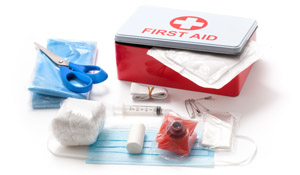
You’ve packed your luggage, purchased tickets, and made hotel reservations or stowed the tent in the back of the car. You’re all ready for vacation, except for one essential thing: your first aid kit.
Whether you’re headed to a campsite or a cruise ship, don’t leave home without a carefully packed kit that contains all the medicines, bandages, and other supplies you’ll need to keep you and your family safe. A first aid is especially important if you’re traveling somewhere that doesn’t have easily accessible medical care available.
What Do You Need in Your First Aid Kit?
That depends on where you’re going, how long you’re staying, and how close you’ll be to an emergency room. If you’re staying in a hotel in a big city and are spending your days sightseeing, you might only need some Band-Aids, pain relievers, allergy medication, and a topical antibiotic/wound cream. Tuck those in your purse, and you’re ready to go.
But if you’re heading out to the backcountry, a foreign country, or a location where basic and emergency medical care is unavailable, you’ll need to pack for all health possibilities, from a sprained ankle to traveler’s diarrhea.
Creating Your Kit
You can buy first aid kits from the Red Cross, but you can also use a small tackle or craft box (great for the car), or a large sealable plastic bag (this works well for backpacks, suitcases, and purses) to make your own. Fill your kit with:
- A first-aid manual (be sure to read it cover-to-cover before packing it)
- Sterile gauze pads of different sizes.
- Adhesive tape.
- Adhesive bandages in several sizes.
- Elastic bandages for wrapping injured areas.
- A splint or stiff material for making one.
- Antiseptic wipes or liquid antiseptic (like hydrogen peroxide).
- Soap and/or hand sanitizer.
- Cotton balls or swabs.
- Petroleum jelly (for abrasions, and chapped skin and lips).
- Aloe vera gel (for sunburns and irritated skin).
- Saline solution (for cleaning out eyes).
- Antibiotic ointment/wound cream.
- Hydrocortisone cream 1% (for bug bites, rashes, and reducing swelling).
- Acetaminophen (Tylenol) and ibuprofen.
- Dramamine (for motion sickness) and anti-diarrheal medicine and/or Pepto Bismol.
- Extra prescription medications for every member of the family.
- Tweezers and a sterile needle (for splinters).
- Sharp scissors (for cutting bandages, adhesives, and other uses).
- Safety pins (to hold elastic bandages and wraps in place or to help secure a makeshift sling).
- Disposable instant cold packs (for sprains and to prevent swelling).
- Calamine lotion (for poison ivy and other skin irritations).
- Oral re-hydration tablets (for dehydration).
- Thermometer.
- Alcohol wipes or ethyl alcohol (to clean tools like scissors, tweezers, and thermometers).
- Plastic non-latex gloves (at least 2 pairs).
- Flashlight and extra batteries.
- A blanket.
- Mouthpiece for administering CPR (can be obtained from your local Red Cross).
Also pack sunscreen, bug spray, and ear drops to prevent swimmer’s ear. If you’re going to be traveling by air, keep security policies in mind and make sure any liquids (including lotions, gels, creams, and pastes) in your purse are in 3.4 oz. or smaller containers. For more information, visit the Transportation Security Administration’s website.
Tips for Different Trips
For Beach Getaways: Stash a small container of baby powder in your beach bag. Dust it on sandy spots (like the insides of bathing suit bottoms and diapers, and on your feet) to quickly remove sand and prevent chafing. Don’t forget to reapply sunscreen frequently (every two hours or immediately after swimming or sweating heavily), and stay in the shade during the heat of the day to avoid dehydration and overheating.
For Camping Trips: Make sure your tweezers are on hand to deal with splinters, and load up on bug spray with 30-50% DEET. Also have some antihistamine available for unexpected allergy attacks. If anyone in your party has a known bee or bug allergy, be sure you have an epinephrine auto-injector (EpiPen) with you at all times.
For Overseas Travel: You’ll want to do some research on any vaccinations and medications you might need at least a month in advance of your trip. If you anticipate eating unfamiliar foods or coming in contact with questionable drinking water, ask your doctor for a just-in-case antibiotic. In addition, the Centers for Disease Control offer these tips for prescription medications:
- Pack your prescription medications in your carry-on luggage.
- Pack copies of all prescriptions, including the generic names for medications.
- Pack a note on letterhead stationery from the prescribing physician for controlled substances and injectable medications.
- Leave a spare copy of your prescriptions at home with a friend or relative.
- Check with the American Embassy or Consulate to make sure that your medicines will be allowed into the country you are visiting. Some countries do not let visitors bring certain medicines into the country.
This article was reviewed by Dennis Bley, DO, Internal Medicine, Broadway Medical Group, Portland, Oregon.
Sources
"Traveler’s Health." Centers for Disease Control and Prevention.
"First Aid Kit." Kids Health from Nemours.
"Travel Medical Kit." Cleveland Clinic.
"3-1-1 Liquids Rule." Transportation Security Administration. Page last revised June 24, 2014.





